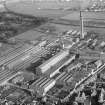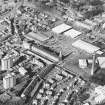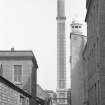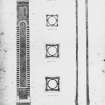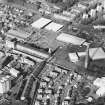Following the launch of trove.scot in February 2025 we are now planning the retiral of some of our webservices. Canmore will be switched off on 24th June 2025. Information about the closure can be found on the HES website: Retiral of HES web services | Historic Environment Scotland
Dundee, Methven Street, Camperdown Works, Cox's Stack
Chimney (19th Century)
Site Name Dundee, Methven Street, Camperdown Works, Cox's Stack
Classification Chimney (19th Century)
Alternative Name(s) Cox's Lum
Canmore ID 165116
Site Number NO33SE 64.04
NGR NO 38282 31636
Datum OSGB36 - NGR
Permalink http://canmore.org.uk/site/165116
- Council Dundee, City Of
- Parish Dundee (Dundee, City Of)
- Former Region Tayside
- Former District City Of Dundee
- Former County Angus
Magnificent 282' 10" chimney stalk in form of Italian campanile, polychrome brick on ashlar base. The best industrial chimney in Scotland. The only comparable structure in England is the India Mill chimney, Darwen, 1867 310 feet. The 2 campanile chimneys in Bradford-Saltaire 1868, circa 150 feet and Manningham, 1873, 250 feet are stone built. The campaniles at Tower Works, Leeds, circa 1900, are much smaller. None match the exuberant decoration of Cox's stack. (Historic Environment Scotland List Entry)
Camperdown works, at its peak, stretched over 35 acres and employed 5000 workers, becoming one of the largest mill complexes in Britain (C McKean & D.Walker).
The American Civil War created greater prosperity for Dundee mill owners, who invested much of the income generated into new buildings. At Den Works, Baxter brothers built 2 new mills and refurbished another along with a new calendar and foundary. At the same time James Mclaren erected the remarkable Cox's Stack at a cost of £6000, with the Gilory's added 2 new blocks to their Tay Works. (Walker &Gauldie)
Following closure of the Camperdown Works in 1981, the entire site was redeveloped with some parts of the former works being retained and converted into residential use. Cox's Stack was originally located adjacent to single storey sheds; these were cleared away during redevelopment to make way for the Stack Leisure Park with the chimney retained as a landmark feature, linking the new commercial park with residential housing.
Publication Account
Cox’s Stack is the tallest surviving example of an industrial chimney in Scotland and is splendidly ornamental. It waserected in 1865–66 and is said to be 282 ft 10 in. high and is in the form of an Italian campanile in polychrome brick on an ashlar base. The battered-sided base is surmounted by a tall square cross-section plinth with angle pilasters and corbels in yellow brick. The main shaft has angle pilasters
with alternate red and yellow horizontal bands, topped by a large cornice above which is an octagonal top section, from which the coping has been removed. The
stack is of square cross-section externally with a circular section lining within.
The architect was James MacLaren and the engineer George A. Cox, one of the three brothers who owned the 30-acre Camperdown Works complex, then the biggest jute mill in the world. Cox also designed other buildings on the site such as the fire-proof High Mill (1857–68) which contains a great quantity of cast-iron in its bell tower and Gothic roofs.
Remarkable Scottish chimneys now long demolished existed at St Rollox Chemical Works, Glasgow, 455 ft high which was 13 ft diameter at the top tapering to 41 ft at the base. At Edinburgh Gas Works, New Street, the chimney, designed by George Buchanan and erected in 1845–46 mainly of brickwork, was 34112
ft high and accommodated smoke from 68 furnaces heating 178 retorts. Its design
parameters which were known may have influenced those adopted for Cox’s Stack. At Edinburgh bricks were used with a tested crushing strength of 440 ton/sq. ft. The chimney’s internal diameter was 11 ft 4 in. at the top and 20 ft at the bottom, but the bottom 70 ft had an additional lining of fire bricks which reduced the diameter to 13 ft. Buchanan designed for a vertical pressure on the base of
8 ton sq. ft, a wind pressure of 40 lb/sq. ft, and adopted a minimum wind overturning safety factor of 2.6.
R Paxton and J Shipway 2007b
Reproduced from 'Civil Engineering heritage: Scotland - Highlands and Islands' with kind permission of Thomas Telford Publishers.

















































